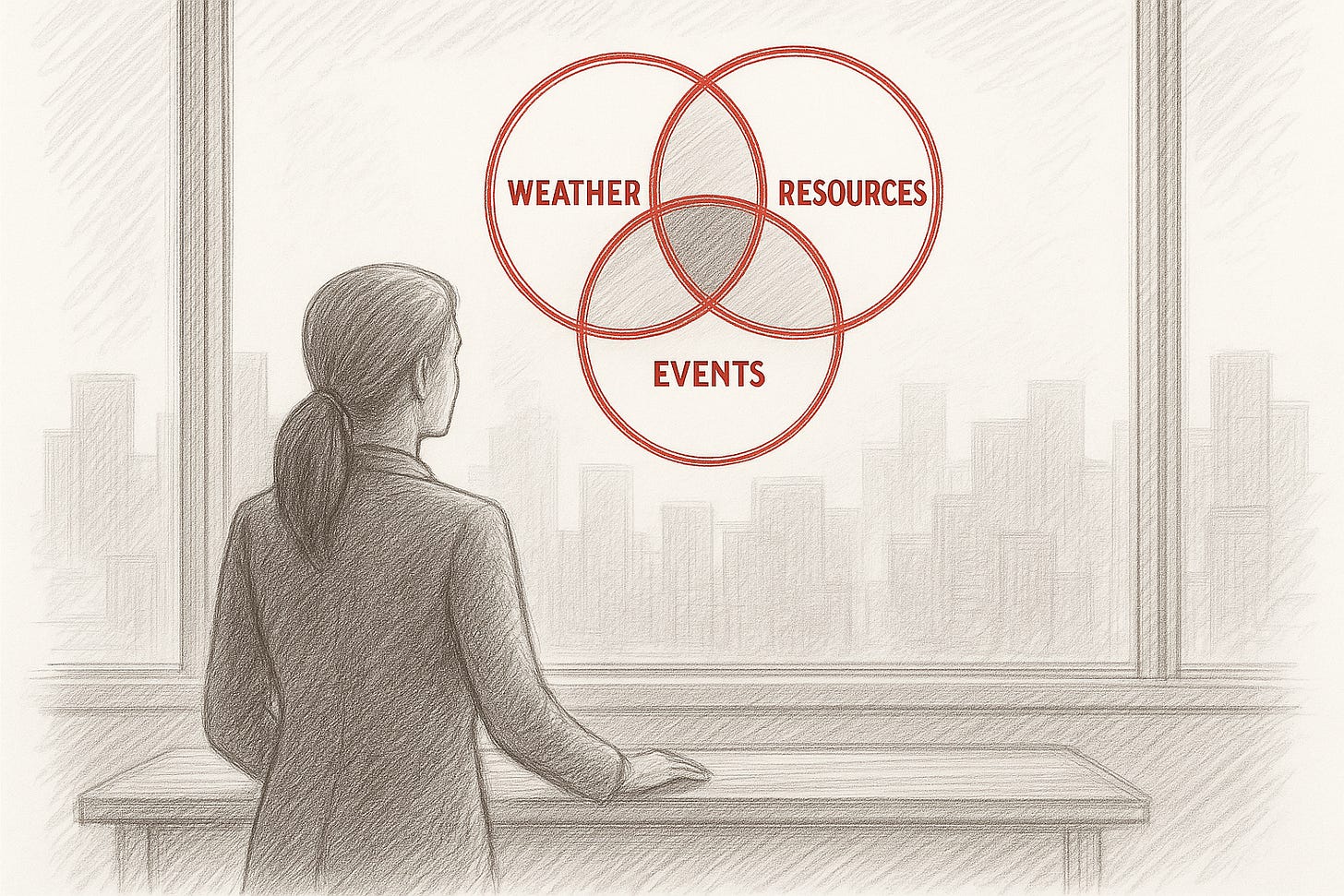The Human Component: When Threats and Hazards Converge
The Executive’s Role in Reading the Operating Environment
Executives bear a responsibility that no dashboard, sensor, or automated tool can replace: recognizing when today is not like yesterday. For public safety leaders and corporate security executives alike, the role isn’t just about managing what has already happened, it’s about spotting the subtle convergence of threats and hazards that shift an ordinary operating environment into one with extraordinary risk.
Understanding Action Points
In a recent discussion about the Watch Points and Action Points of a wind-driven wildfire with a client, three Action Points stood out:
Winds over 40 mph. When winds exceed this threshold, air assets can’t fly effectively, limiting firefighting capacity just as fire behavior intensifies.
Other fires burning in the region. When regional incidents pull resources away, the usual reinforcements may no longer be available.
Major events in the city. Large gatherings change the risk profile, complicating evacuations if a fire does start.
Action Points are the moments that force organizations to shift how they operate while still “left of bang.” But these decisions carry their own risks. Call in off-duty staff too soon, and budgets strain under overtime costs. Warn the public too early, and credibility may suffer if the event never materializes.
Executives must weigh not only safety and budget but also the political dimension and public trust, knowing that each decision shapes how their communities or organizations will respond to them the next time.
The Tactical Convergence of Threats and Hazards
In isolation, each of these conditions is familiar and often manageable.
Winds above 40 mph sweep across a region many times each year without sparking disaster.
Fire agencies routinely send crews and equipment to neighboring jurisdictions through mutual aid, confident their own readiness will hold.
Large gatherings are not only common but essential as they bring connection, identity, and revenue to a community.
None of these factors, on their own, would justify sounding an alarm or changing normal operations.
It is when they converge that the picture changes. High winds, a stretched fire service, and a mass gathering happening simultaneously transform what would otherwise be routine circumstances into a volatile, high-stakes environment. The ordinary becomes extraordinary and the decision threshold for leaders shifts accordingly.
This is why executives must think differently. Risk isn’t linear. It’s dynamic and contextual. It isn’t a formula that says “2 parts of A, plus 1 part of B, plus 3 parts of C equals danger.” Instead, it is the recognition of a combination of weak signals: a shift in weather patterns, a strain on organizational readiness, and a temporary spike in exposure because of a mass gathering. None of these alone may trigger a dashboard alarm, yet together they can create conditions where normal operations no longer apply.
The Executive’s Unique Role
At this point in time, recognizing these conditions remains a distinctly human responsibility. Spotting weak signals is possible, but only if executives are presented with clear, clean facts, and only if they maintain the discipline to engage with them.
Executives bring a unique perspective:
They know that a hot weekend isn’t just “heat” when thousands are sitting on metal bleachers at an airshow with little shade and limited medical support.
They understand that a thunderstorm isn’t just “rain” when it hits an outdoor concert venue where most attendees biked in and have no shelter options.
They see that an RSV surge isn’t just “seasonal illness” when it reduces hospital capacity to care for children during otherwise manageable emergencies.
And in the corporate world, they recognize that a supply chain disruption isn’t just “delayed shipments” when it coincides with severe weather grounding air travel and a cyberattack targeting logistics systems.
These examples underscore that executives are not operators. They are interpreters of convergence charged with seeing connections others can’t, and making left of bang decisions on behalf of their organizations and communities.
Why Situational Reports Must Be Multidimensional
This is why Situation Reports and the methodology in our Operational Readiness Playbook integrate four distinct domains of risk:
Weather and natural environment (7-day forecasts, watches and warnings, and long-term changes)
Safety and security (planned protests, large gatherings, local crime/safety trends)
Health and medical (disease, capacity, public health signals)
Cybersecurity (technology-driven threats and vulnerabilities)
Few of these categories alone justify proactive executive action. But when they intersect—when hot weather meets mass gatherings, when medical surges coincide with severe weather, when cyber disruptions strike during public safety incidents—the risk landscape transforms.
The Disciplines Executives Must Embrace
For executives to fulfill their unique role, three disciplines are essential:
Build capability. Create a forward-looking situational awareness function that curates and delivers the information you need.
Maintain discipline. Read and internalize reports consistently, even when most weeks require no direct action.
Accept responsibility. Executives are the only ones with the perspective and authority to make these tradeoffs. This responsibility cannot be outsourced.
Conclusion
The convergence of threats and hazards rarely announces itself with a siren. It is subtle, dynamic, and humanly recognizable. Executives who discipline themselves to see these overlaps—before bang—are the ones who protect their communities, their organizations, and their people when conditions quietly shift from routine to dangerous.
The most practical step a leader can take this week is to identify the Watch Points and Action Points that truly matter in their environment—whether that’s wind thresholds, hospital capacity, planned protests, or cyber dependencies—and then build the processes to ensure those conditions are presented clearly, consistently, and in time to act.
That is why we built and shared our process for building Situation Reports and Operational Readiness Playbook: to give senior leadership teams not just information, but the clarity to make the decisions only they can make.


